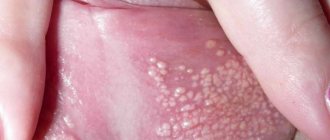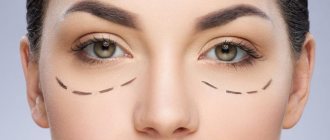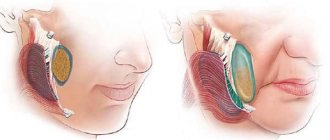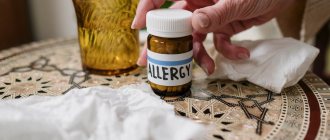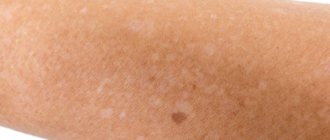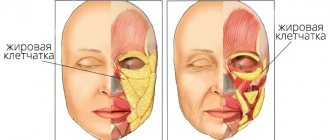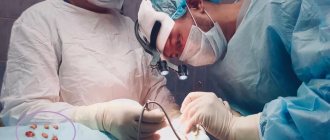Are you worried about small white pimples on your face that resemble millet grains? Are you looking for an effective recipe for removing them, but still haven’t found such a technique? Do you want to find out as much information as possible about what modern salon and folk methods can be used to solve this aesthetic problem? In this article you will find answers to all your questions!
For our subscribers on Instagram, our partner will send an anti-wrinkle complex based on adapalene ADAPALEX™ for free . The offer is valid for a limited time , subscribe and pick up via the link.
General information
The term “ milium ” refers to whiteheads, which mainly appear due to overactive activity of the sebaceous glands.
The name comes from the Latin word for millet. Therefore, in everyday life this disease is also called millet. This cosmetic defect does not cause harm to health. Milia feel like small nodules to the touch. Most often, millet appears on the face; the most typical disease is for women and newborns. However, milia on the face or on another part of the body is not a pimple, but a benign formation. Apart from the white formations themselves, this phenomenon does not provoke any other symptoms. Therefore, treatment is carried out only if millet causes cosmetic discomfort.
Pathogenesis
Another name for this manifestation is retention miliary cysts . In the process of chemical analysis of the contents of milia, it was determined that it contains keratin - dead cells mixed with fat. Their structure is dense, not similar to the contents of acne , since they contain relatively little sebum. These formations are small - their diameter is no more than 2 mm. The milia capsule is located separately from the sweat and fat ducts. The formations are localized mainly on the cheekbones, eyelids, temples, forehead, and near the lips. They rarely form on the chin. Milium has a cystic structure, and there are no passages outward, so it is difficult to squeeze out the formation.
Such acne forms due to specific processes. Apoptosis is the process by which damaged, overproduced and old cells in the body are eliminated. But sometimes apoptosis is disrupted, which leads to the development of a number of skin diseases, including the formation of milia.
The surface of the skin is renewed every 2-4 weeks. However, this process is correct and timely only when a sufficient level of cell apoptosis occurs in the skin and the intercellular substance is renewed in a timely manner. The intercellular substance consists of collagen and elastin . In the intercellular space, elastin and collagen fibers are removed by fibroblasts - special cells. But if their activity is insufficient, then the old fibers are not removed, but become denser and close the cell, preventing the entry of necessary substances into it and the removal of metabolic products. As a result, keratinocytes die, but they are not removed. Dead cells remain in the skin, surrounded by a sheath of connective tissue. As a result, milia appear. It is impossible to remove these formations using acne treatment products.
This type of formation also sometimes occurs in newborns. During the period of intrauterine development of the fetus, sebaceous glands are formed already in the third month. The impact of a number of factors on the body of the expectant mother leads to the development of milia in newborns. As a rule, after some time their number becomes smaller and they disappear on their own.
What are milia?
A small formation in the place where hair begins to grow is called millet. These are dense nodules that are localized mainly on the face in areas with thin skin. They are painless, not prone to growth and inflammation. Their diameter ranges from 0.5 to 3 mm. Rarely, milia can appear on the body or in the groin area. Age category - any, but most often millet is observed in women, newborns and adolescents.
Exocrine glands are located in the dermis, their ducts are often directed to the mouth of the root part of the hair. Each of them secretes sebum, a fatty substance that is a lipid complex.
When released onto the surface of the dermis, the secretion forms a special invisible film, which consists of water and lipids, and is intended for protective functions. In addition, dead epidermal cells are shed through the base of the follicle. When the gland becomes clogged with sebum and horny scales, milia are formed. The formation is called millet because of its similarity to millet grain and its color (white, yellowish).
Classification
Milia are divided into two types:
- Primary - they develop spontaneously, they can be a consequence of the influence of ultraviolet radiation, etc. This type develops in newborns. As soon as the processes of separation of keratinized skin particles return to normal, this manifestation disappears. In adults, the primary form can be a consequence of hormonal imbalance, hyperkeratosis , poor hygiene, abuse of cosmetics, etc.
- Secondary - are a consequence of inflammation or trauma to the skin, developing in scars after wounds or burns. Unlike primary ones, they do not disappear on their own and can remain in scars throughout life.
No. 3 Medicines
Medicines may be required in cases where the problem lies in hormonal imbalance or diseases of the digestive tract. Patients are prescribed enterosorbents - activated carbon, white carbon, Smecta.
Vitamin complexes are useful , especially those with a high content of B vitamins and yeast. You can take immunostimulants. Hormonal drugs are prescribed only by a doctor and only after a full medical examination.
Dietary supplement Inneov Clear skin
As for topical products for milia, the following can be used: zinc, sulfur and tar ointments, Erythromycin also in the form of an ointment (has an antibacterial effect), boric acid (or salicylic acid) is suitable for wiping and disinfecting the skin.
Find out how to properly apply sulfur-tar ointment.
These drugs eliminate pathogens, promote healing, regulate the body's hormonal balance and the functioning of the digestive tract, and also stimulate the defenses.
Be sure to read:
Causes of rosacea on the face (rosacea) and methods of treatment
Causes of blemishes on the face
The main reasons why so-called whiteheads develop under the skin on the face are associated with excessive production of keratin by cells. This phenomenon can be caused by the following factors:
- hormonal imbalance;
- hyperkeratosis;
- incorrect metabolic processes;
- thyroid dysfunction;
- digestive diseases;
- prolonged exposure to direct sunlight;
- incorrect approach to nutrition - consumption of large amounts of fatty and fried foods;
- of vitamins important for the body ;
- diseases of the adrenal glands and pancreas.
Due to hormonal imbalance, millet often appears not only in adults, but also in infants. When a baby is born, his body experiences a significant hormonal crisis, which leads to problems with the skin.
Another peak in the appearance of milia occurs during adolescence. During this period, very often keratinized cells are separated incorrectly, the regulation of sebum production is disrupted, and as a result, millet appears on the skin in parallel with acne. In adolescents, this is associated with the following phenomena:
- oily seborrhea , when there is hyperfunction of the sebaceous glands;
- increased levels of sex hormones;
- dysfunction of the autonomic nervous system;
- deficiency of vitamins and minerals;
- improper skin care, insufficient hygiene;
- hyperkeratosis of the hair follicle;
- abuse of junk food - soda, fast food, sweets;
- use of low quality cosmetics;
- dry skin due to improperly performed cosmetic procedures;
- side effects when using medications;
- inflammation of the skin, benign formations;
- ultraviolet action;
- bad habits.
The appearance of such formations may be associated with diseases, the course of which negatively affects the condition of the skin:
- bullous pemphigoid;
- porphyria cutanea tarda ;
- dystrophic epidermolysis bullosa ;
- lupus;
- sarcoidosis;
- gastrointestinal diseases;
- endocrine disorders.
No. 1 Skin care rules
It is important for patients to eliminate overproduction of sebum and prevent clogged pores. To do this, you need to give up decorative cosmetics with a dense texture (especially during the treatment period). All care products should be light, hypoallergenic, and made from natural ingredients.
Cleansing is of great importance. This procedure should be daily, carried out in the morning and evening. The choice of cleansing products is very large, you can easily choose the optimal one (together with a cosmetologist).
You just need to remember that you cannot further injure the skin; the manipulation should be gentle.
Symptoms
Most often, such formations appear on the face. Often, millet forms on the eyelid, and milia develop under the eyes. While milia on the eyelids are a fairly common occurrence, they appear less frequently on the limbs, abdomen, and genitals. These formations can appear at any age. Millet does not cause pain, discomfort or any unpleasant sensations.
The millet looks like a papule no larger than 2 mm in size. These white pimples can appear singly, but most often they form in groups. In appearance, these are small, round, dense nodules that have a yellow-white tint. The head of the pimple is not inflamed, but if microorganisms get inside, the formations can become inflamed and become purulent.
Sometimes, after a person has managed to get rid of such a manifestation, milia appear again.
When should you see a doctor for treatment?
In most cases, millet is harmless and only causes aesthetic inconvenience. Acne forms gradually, without discomfort or inflammation. They can be observed in the form of individual nodules, but more often they are a scattering localized on the eyelids, temples, and in the T-zone. Since the cysts are tightly sealed and have no contact with the environment, they maintain their size. But if the integrity is violated and pathogenic microorganisms enter, inflammation with pustules can develop.
Milium is easily recognized visually by a cosmetologist. But in some cases it needs to be differentiated from fibroma, flat xanthoma, or hamartoma of the eyelids.
Tests and diagnostics
A dermatologist diagnoses milia by examining the skin and identifying characteristic signs. The doctor interviews the patient, studies the medical history and collects anamnesis to determine the cause that triggered the development of millet.
Instrumental and laboratory studies, as a rule, are not practiced. If milia appear against the background of other diseases, the patient is advised to consult with specialists.
It is important to differentiate milia from fibrofolliculoma , trichodiscoma , fibroma , syringoma and xanthelasma .
Procedures and operations
The most common procedure for removing millet grass is the mechanical method. First, the skin is treated with an antiseptic. Then the specialist uses a sterile needle, opens the membrane, lifts the cyst and pushes it out. For this purpose, a special curette that resembles a spoon is also used. This tool makes it possible to completely scrape out the milia, and then the remnants of its contents will not turn into a cyst again after some time. In one procedure, a certain number of formations are removed – no more than 10.
Milia under the eyes are removed using radio waves , and diamond cleaning . A more aggressive method is burning ( laser removal, electrocoagulation ), which acts on the formations in a targeted manner.
Sometimes milia disappear on their own after a few months as the skin renews itself.
It is also important to ensure proper skin care and use products that will help normalize the oiliness of the epidermis.
Varieties
White pimples come in the following types:
- primary – occur when exposed to unfavorable factors;
- secondary – observed in places where scar tissue forms.
White primary pimples often occur in newborns due to imperfections in the natural mechanisms for removing horny particles. This phenomenon is temporary. After a few months, white pimples disappear on their own without treatment. Squeezing or scraping milia with your fingernail is not recommended.
If pimples are located close to each other, there is a groove between them. However, they do not merge with each other.
Treatment with folk remedies
You can use folk methods to combat millet grass. But most of them can produce an effect only with regular and long-term use. All traditional methods are based on mechanical cleansing of the skin from dead cells. When using products that act as peeling, you need to rub the skin very gently. Gradually, the milia coating will become thinner, and it will be possible to remove it yourself without damaging the skin.
- Soda and soap. First, you need to foam baby soap on your palm, then pour 1 tbsp onto the foam. l. soda Treat the skin with gentle movements and rinse off the composition. Use every other day for two weeks.
- Paraffin. Melt 70 g of paraffin in a water bath. Wipe your face with alcohol and apply several layers of paraffin to your face. The next layer can be applied when the previous one has hardened. Remove the mask when the paraffin has completely hardened.
- Pumpkin with sour cream. Finely grate the pumpkin pulp and mix it with sour cream to form a homogeneous mass. Apply the mask to your face and leave it for a quarter of an hour. The mask can be applied every day.
- Sea salt and olive oil. Mix these two components in equal proportions, take the mixture onto a cotton pad and lightly massage the affected areas. After this procedure, apply a moisturizer to your face.
- Viburnum with oatmeal. Grind the berries in a blender, add a little oatmeal and apply to the affected areas for 20 minutes. Rinse everything off with water.
- Yeast. 1 tbsp. l. mix yeast with 1 tbsp. l. lemon juice and the same amount of honey and hydrogen peroxide. Mix everything and apply to skin for 20 minutes. After this, rinse gently with water.
hydrogen peroxide at home to treat millet so as not to worsen the condition.
Prevention
To prevent the formation of millet, the following prevention rules should be followed:
- Visit a doctor in a timely manner and identify pathologies of organs and systems. Monitor hormonal balance.
- Protect the skin from the aggressive effects of ultraviolet radiation. Use special protective equipment.
- Eat right, avoiding vitamin and mineral deficiencies and avoiding junk food. It is important to prevent a lack of zinc (it is found in protein products) and calcium (dairy products). You should not starve or adhere to too strict diets.
- Take proper care of your facial skin by selecting products with the help of professional cosmetologists. It is important to consider your skin type.
- Strictly monitor skin hygiene.
- Regularly carry out procedures aimed at properly exfoliating dead cells.
- As recommended by your doctor, take vitamin and mineral complexes.
№5 Nutrition
During the treatment period, it is recommended to abstain from alcoholic beverages; in the future, the amount of alcohol should be significantly limited. The diet should contain a sufficient amount of lean meats and fish, vegetables and fruits. Dairy products must be low-fat. It is important to drink at least 1.5-2 liters of water per day, this will help cleanse the body. Cereals, bread and pasta made from durum wheat are also useful.
Fatty, fried, salty, floury foods should be avoided. The same goes for sweets, chocolate, coffee and tea. As for the latter, you can drink green varieties of the drink.
Diet
Diet for acne
- Efficacy: therapeutic effect after 21-30 days
- Terms: 6-8 months
- Cost of products: 1700-1800 rubles. in Week
To prevent milia from occurring, you need to eat well, but not overeat or abuse junk food. In this case, it is advisable to adhere to the principles of the Acne Diet . The following products must be included in the menu:
- Lactic acid dishes - they will help improve the condition of the intestinal microflora.
- Liver, offal, seeds, nuts - they will help compensate for zinc deficiency.
- Fish of all varieties contains Omega-3 fatty acids , which have an anti-inflammatory effect.
- Vegetables, fruits, fresh herbs are sources of vitamins and antioxidants .
- Green tea is a powerful antioxidant.
Consequences and complications
If you deal with this cosmetic problem correctly, there will be no unpleasant consequences. But if there is an unprofessional approach to eliminating the pimples and incorrect actions at home, wounds, bruises, and later scars may remain in place of the pimples.
Infection in the resulting wound can lead to inflammation, abscess and other unpleasant diseases.
The risk of complications when removing milia in the eye area on your own is very high. When an infection occurs, an abscess of the eyelid may develop. There is also a risk of injuring the eyeball when using a needle.
Bacteria entering the eyelid area can lead to them subsequently ending up in the orbital veins, and later in the sinuses of the brain. As a result, sinus thrombosis may develop.
Recommended ointments
To get rid of milia at home, the following formulations are recommended:
- sulfur, salicylic or zinc ointments, which have drying, regenerating, brightening and antibacterial properties. They are applied in a thin layer to cleansed skin in areas of existing rashes every day at night for 10 days;
- pharmaceutical ointment "Retinol" applied in a thin layer locally (on the grass) after washing the skin. It is strictly forbidden to apply this ointment to the area near the eyes to avoid burns and irritation of this delicate and especially sensitive epidermis!
- ichthyol ointment, which has an unpleasant odor, but is very effective in the fight against milia, characterized by anti-inflammatory, antimicrobial, powerful regenerating and improving local blood circulation effects. Cosmetologists strongly recommend using this ointment after performing mechanical or hardware cleansing of the skin, including for preventive purposes. It is recommended to apply it to rashes only in the evening, before bed.
Pharmacy ointment "Retinol" will help in the fight against milia.
